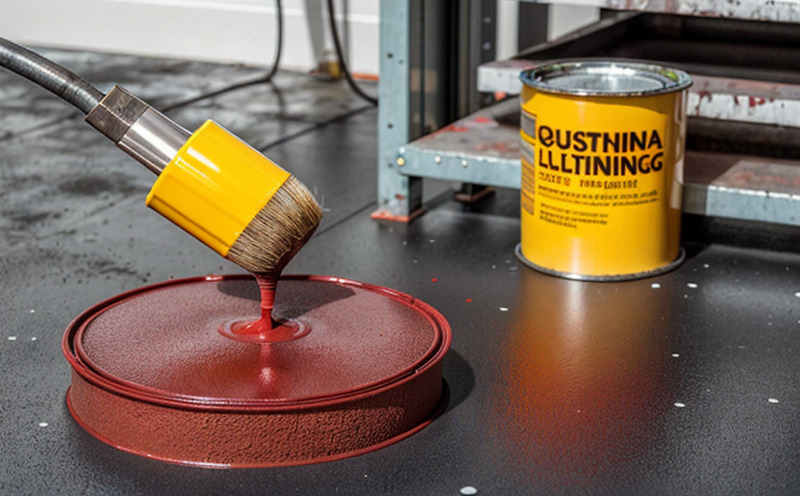ASTM G85 Cyclic Corrosion Testing of Paints
The ASTM G85 cyclic corrosion test is a critical procedure used to evaluate the resistance of coatings, paints, and surface treatments against cyclic exposure conditions. This testing method simulates real-world environmental stresses that can lead to degradation over time. By subjecting specimens to alternating wetting and drying cycles, the test assesses the durability and adhesion of protective coatings in industrial environments.
The cyclic corrosion test is particularly relevant for industries such as automotive manufacturing, aerospace, construction, and chemical processing where surface integrity plays a crucial role in product longevity. The test helps ensure that materials used in these sectors meet stringent quality standards, thereby enhancing the reliability and performance of final products.
In this context, ASTM G85 is part of a broader suite of testing methods designed to address specific aspects of coating durability. For instance, ASTM D6101 covers salt spray tests for evaluating the resistance of paints used in outdoor environments, while ASTM F2341 focuses on freeze-thaw cycling, which simulates seasonal temperature fluctuations.
The cyclic corrosion test involves exposing painted specimens to controlled cycles of immersion and drying. The testing parameters are carefully defined according to the standard, ensuring consistency across different laboratories. Key factors include the duration of each cycle, the type of salt solution used for immersion, and the humidity levels during drying phases.
Preparation of specimens is a critical step in ASTM G85 cyclic corrosion testing. Specimens must be cleaned thoroughly to remove any contaminants that could interfere with the test results. After cleaning, samples are carefully prepared according to the specifications outlined in the standard. This includes ensuring uniform coating thickness and adhering to specific dimensions as dictated by ASTM G85.
The actual testing process involves placing the specimens into a specially designed chamber where they undergo repeated cycles of immersion in saltwater followed by drying periods. The cycles are precisely controlled, with exact times for each phase recorded meticulously. During these cycles, the specimens are continuously monitored for any signs of degradation or loss of adhesion.
Following completion of the test, detailed analysis is conducted to assess changes in coating integrity and adhesion. This includes visual inspections as well as more quantitative methods like cross-sectioning and microscopy. The results provide valuable insights into how well the coatings perform under cyclic corrosion conditions, helping manufacturers make informed decisions about material selection and formulation.
ASTM G85 cyclic corrosion testing is not only a regulatory requirement but also an essential tool for quality assurance in industrial manufacturing processes. It ensures that materials used in critical applications can withstand harsh environmental conditions without compromising performance or safety standards.
Applied Standards
- ASTM G85: Standard Practice for Cyclic Exposure Testing of Paints and Related Coatings
- ISO 11994: Determination of the Resistance to Salt Spray Corrosion of Painted or Coated Surfaces by Cycling Methods
The ASTM G85 standard provides comprehensive guidelines for conducting cyclic corrosion tests on paints and related coatings. It specifies the materials required, the procedures to follow, and the criteria used to interpret results accurately. Compliance with these standards ensures that testing is conducted consistently across various laboratories, leading to reliable and comparable data.
ISO 11994 further complements ASTM G85 by offering additional insights into the resistance of painted or coated surfaces against salt spray corrosion through cycling methods. This international standard emphasizes the importance of accurate and reproducible testing protocols, which are crucial for ensuring consistent quality in industrial applications.
Why Choose This Test
- Comprehensive Evaluation: ASTM G85 cyclic corrosion testing offers a thorough assessment of coating durability under cyclic environmental conditions, providing valuable insights into long-term performance.
- Regulatory Compliance: Ensures adherence to industry standards and regulatory requirements, facilitating smoother compliance processes for manufacturers.
- Enhanced Product Quality: By identifying weak points early in the development process, ASTM G85 helps improve product quality, leading to more reliable products.
- Cost Efficiency: Early detection of potential issues reduces costly rework and enhances overall efficiency throughout the production cycle.
Competitive Advantage and Market Impact
ASTM G85 cyclic corrosion testing provides a clear competitive edge by ensuring that products meet or exceed industry standards. This not only enhances customer confidence but also positions companies as leaders in innovation and quality assurance. By consistently delivering high-quality materials, businesses can differentiate themselves in the market, attracting discerning customers who value reliability and longevity.
In today's highly competitive landscape, maintaining stringent quality control measures is key to sustaining a strong brand reputation. ASTM G85 cyclic corrosion testing plays a pivotal role in this regard by offering robust data that supports marketing claims and builds trust with end-users. This approach fosters customer loyalty and opens new market opportunities as companies gain recognition for their commitment to excellence.
Moreover, the ability to demonstrate compliance with international standards like ASTM G85 can open doors to global markets where strict quality regulations are enforced. By meeting these stringent requirements, businesses can penetrate diverse geographical regions, expanding their customer base and driving growth.





